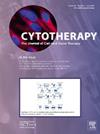Severe hypophosphatemia following idecabtagene vicleucel regardless of the severity of cytokine release syndrome
IF 3.7
3区 医学
Q2 BIOTECHNOLOGY & APPLIED MICROBIOLOGY
引用次数: 0
Abstract
Background aims
Hypophosphatemia has been recently recognized adverse event in chimeric antigen receptor (CAR)-T cell therapy, complicating 70–75% of patients. Severe hypophosphatemia can cause cytokine release syndrome (CRS)-like symptoms, such as respiratory and cardiovascular dysfunction. Some reports have described the association between inorganic phosphate (iP) and CRS in patients treated with tisagenlecleucel (tisa-cel), lisocabtagene maraleucel (liso-cel), axicabtagene ciloleucel (axi-cel). However, the association between iP and idecabtagene vicleucel (ide-cel) has not been reported and the kinetics of serum iP for each CAR-T cell product have not been compared. We aimed to analyze the kinetics of iP with CAR-T cell products, including ide-cel, and the association between hypophosphatemia and severe CRS.
Methods
We retrospectively analyzed patients aged ≥ 18 years with B-cell malignancies who received CAR-T cell therapy in our institution. All available laboratory data were collected for 21 days after CAR-T cell infusion; clinical and laboratory data were extracted from electronic medical records.
Results
A total of 108 patients were treated with CAR-T cell therapy (tisa-cel, n = 56; liso-cel, n = 11; axi-cel, n = 28; ide-cel, n = 13). The cumulative incidence of hypophosphatemia and severe hypophosphatemia were significantly higher in the ide-cel group than the other CAR-T products group (92.3% versus 67.5%, P = 0.0045, and 15.4% versus 2.1%, P = 0.017), Patients treated with ide-cel had significantly lower serum iP levels from day −4 to 8 compared to other CAR-T products. As previous reports, the cumulative incidence of hypophosphatemia in the other CAR-T products group was significantly higher in the severe CRS group than in the mild CRS group (84.0% versus 60.0%, P = 0.0002). In contrast, there was no significant difference between the two groups in the ide-cel group (65% versus 100%, P = 0.13).
Conclusion
Our results suggest that and that it is important to monitor iP kinetics more carefully because patients treated with ide-cel complicate severe hypophosphatemia, regardless of CRS severity.
求助全文
约1分钟内获得全文
求助全文
来源期刊

Cytotherapy
医学-生物工程与应用微生物
CiteScore
6.30
自引率
4.40%
发文量
683
审稿时长
49 days
期刊介绍:
The journal brings readers the latest developments in the fast moving field of cellular therapy in man. This includes cell therapy for cancer, immune disorders, inherited diseases, tissue repair and regenerative medicine. The journal covers the science, translational development and treatment with variety of cell types including hematopoietic stem cells, immune cells (dendritic cells, NK, cells, T cells, antigen presenting cells) mesenchymal stromal cells, adipose cells, nerve, muscle, vascular and endothelial cells, and induced pluripotential stem cells. We also welcome manuscripts on subcellular derivatives such as exosomes. A specific focus is on translational research that brings cell therapy to the clinic. Cytotherapy publishes original papers, reviews, position papers editorials, commentaries and letters to the editor. We welcome "Protocols in Cytotherapy" bringing standard operating procedure for production specific cell types for clinical use within the reach of the readership.
 求助内容:
求助内容: 应助结果提醒方式:
应助结果提醒方式:


